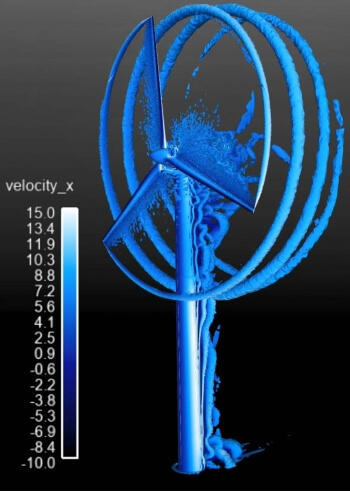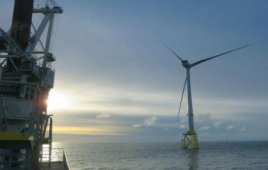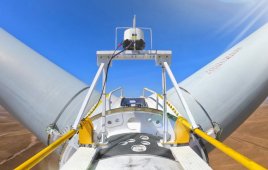
Wind-turbine velocities modeled with Nalu-Wind. The Nalu-Wind work is part of DOE’s Atmosphere to Electrons initiative, a multi-year, multi-stakeholder R&D effort focused on improving wind plant performance and mitigating risk. (Image: Matt Barone, Stefan Domino, & Chris Brune with Sandia)
Researchers at Sandia National Laboratories (Sandia) and National Renewable Energy Laboratory (NREL) are using advanced national supercomputing resources to develop an open-source computational fluid dynamics (CFD) code that simulates wind plants with greater accuracy than previously possible.
This Nalu-Wind code is emerging as the foundation for next-generation wind power plant flow modeling, enabling operators and developers to predict blade health, power production, and plant costs more accurately to ultimately reduce the overall cost of wind energy. (Nalu-Wind is a generalized unstructured, massively parallel, variable density turbulent flow capability designed for energy applications, such as wind energy).
A recent test used high-resolution wind plant data from the Sandia Scaled Wind Farm Technology (SWiFT) facility to validate a Nalu-Wind simulation. The test indicated that Nalu-Wind can effectively model the turbulence in the air between and around wind turbines — an important step toward simulating wind plants.
“Nalu-Wind is about optimization to lower the cost and improve efficiency,” explained Brian Naughton, a field experiment engineer at Sandia. “The SWiFT site provides us with the unique measurements capabilities needed for Nalu-Wind validation.”
Simulations performed using Nalu-Wind could also make it possible to explore new technologies more quickly and cost-effectively than traditional field testing, translating R&D into high-value wind plants across the country.
More accurate, validated models could improve wind plants’ performance, efficiency, and reliability while lowering the cost of wind energy. By validating that Nalu-Wind accurately simulates how turbines interact, Sandia and NREL’s research is the first step toward a tool that could be used by industry.
Results of this collaborative undertaking will be presented at the American Society of Mechanical Engineers Joint Fluids Engineering conference in July. Learn more here.
Filed Under: News, Software




